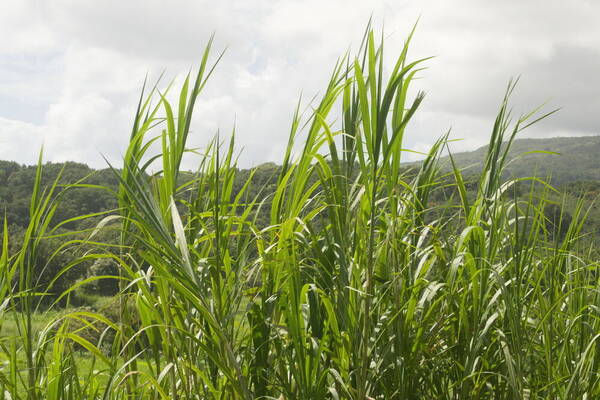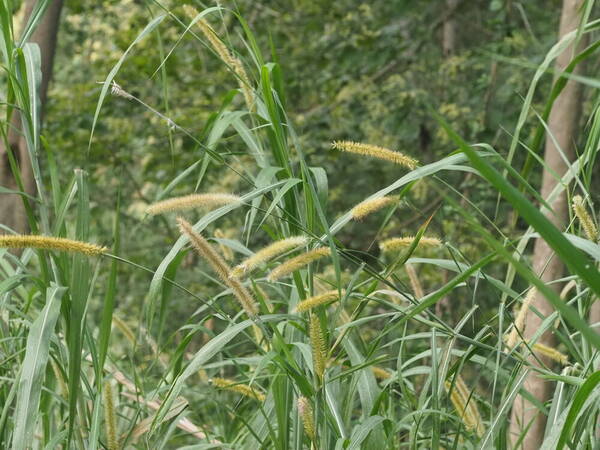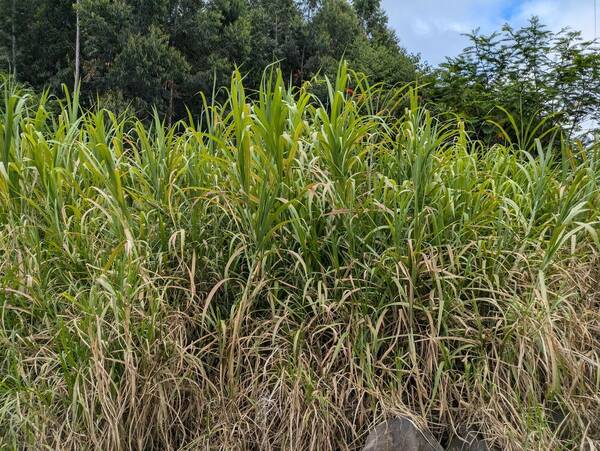Info
Subfamily: Panicoideae
Genus etymology: Cenchrus = "millet" [Greek]. However this is a misnomer, the only millet species in this genus is C. americanus, and this was treated as Pennisetum when Cenchrus was erected.
Species etymology: purpureus = "purple" [Latin] apparently refering to the bristles & lemmas, but they are rarely seen this color
Photosynthetic type: C4 (warm season)
Nativity: naturalized - intentional
First recorded in Hawaiʻi: 1912
Map


Inflorescence





Plant








Habit






Spikelets




Landscape

Description
Robust perennial, often forming bamboo-like clumps; culms 1–6 m. high or more. Leaf-blades up to 120 cm. long, 4 cm. wide. Panicle linear, 7–30 cm. long; rhachis cylindrical, with or without short peduncle-stumps, pubescent; involucre enclosing 1–5 spikelets, one of them sessile and hermaphrodite, the others shortly pedicelled and ♂ (but scarcely different in appearance); bristles glabrous or obscurely ciliate, the longest 10–40 mm. Spikelets lanceolate, 4.5–7 mm. long, glabrous; lower glume 0; upper glume 1/4–1/2 the length of the spikelet, rarely 0; lower lemma 2/3 to as long as the spikelet (rarely less), ♂ or barren, membranous, acuminate; upper lemma subcoriaceous and shining in the lower half, acuminate; anther tips bearing a tiny tuft of hairs (very rarely glabrous). Fig. 156.
(Description source: Clayton, W.D. & Renvoize, S.A. 1982. Flora of Tropical East Africa. Gramineae (Part 3). A.A. Balkema, Rotterdam. 448 pp. )
Robust perennial, often forming bamboo-like clumps. Culms 1–6 m. high. Leaf laminae up to 120 cm. long and 4 cm. wide. Panicle 7–30 cm. long, linear; rhachis cylindrical, with or without short peduncle stumps, pubescent; involucre enclosing 1–5 spikelets, one of them sessile and bisexual, the others shortly pedicelled and male (but scarcely different in appearance); bristles glabrous or obscurely ciliate, the longest 10–40 mm. Spikelets 4.5–7 mm. long. Inferior glume suppressed, the superior 1/4–1/2 length of spikelet or rarely suppressed. Inferior lemma 2/3 to as long as spikelet (rarely less). Superior lemma subcoriaceous and shining in the inferior half; anther tips bearing a tiny tuft of hairs (very rarely glabrous).
(Description source: Launert, E. & Pope, G.V. (eds.). 1989. Flora Zambesiaca. Volume 10. Part 3. Kew, London. 152 pp. )
Plants perennial; sometimes rhizomatous. Culms 2-8 m, erect, pubescent beneath the panicle; nodes glabrous or pubescent. Sheaths glabrous or pubescent; ligules 1.5-5 mm; blades 23-125 cm long, (4)12-40 mm wide, flat, glabrous or pubescent. Panicles terminal, 8-30.5 cm long, (10)30-50 mm wide, fully exerted from the leaf sheaths, erect, golden-yellow to dark purple; rachises terete, pubescent. Fascicles 30-40 per cm, disarticulating at maturity; fascicle axes 0.5-1.5 mm, with 1-5 spikelets; outer bristles 20-63, 1.5-10.3 mm, yellow or purple, scabrous; inner bristles 4-6, 9.1-11.5 mm, yellow or purple, sparsely long-ciliate; primary bristles 13-40 mm, noticeably longer than the other bristles, yellow or purple, scabrous. Spikelets 5.9-7 mm, pedicellate; pedicels of terminal spikelets 0.2-0.4 mm, of other spikelets 1.8-3 mm; lower glumes absent or to 0.8 mm; upper glumes 0.8-3 mm, 0-1-veined; lower florets sterile or staminate; lower lemmas 4-5.3 mm, 3-5(6)-veined; lower paleas 4-4.7 mm; anthers absent or 2.2-3.1 mm, penicillate; upper lemmas 4.5-7 mm, subcoriaceous, shiny, 5-7-veined, acuminate; anthers 2.7-3.6 mm, penicillate. Caryopses 1.8-2.2 mm. 2n = 28.
(Description source: Barkworth, M.E., Capels, K.M., Long, S. & Piep, M.B. (eds.) 2003. Flora of North America, north of Mexico. Volume 25. Magnoliophyta: Commelinidae (in part): Poaceae, Part 2. Oxford University Press, New York. 783 pp http://floranorthamerica.org/Cenchrus_purpureus )
Stout perennials; culms tufted, forming large clumps, erect, bases often decumbent and rooting, up to 80 dm tall, 1-2.5 cm in diameter, solid or hollow, sparingly branched, usually glabrous, glaucous, or sometimes pubescent near summit, nodes not prominent, glabrous or sometimes appressed-hispid. Sheaths glabrous or sometimes papillose-hirsute; ligule a minute membrane, bearing a dense row of long, stiff, white hairs 1.5-3.5 mm long; blades up to 125 cm long, up to 40 mm wide, glabrous to papillose-pubescent, midrib prominent on lower surface, margins strongly scabrous. Panicles golden yellow to purple, cylindrical, up to 30 cm long, 1-2 cm in diameter (excluding longest bristles), rachis cylindrical, densely pubescent, the hairs white, fascicles bearded at base with short white hairs, involucral bristles numerous, usually golden brown, scabrous, of varying lengths up to 10-15 mm long, the inner bristle thicker, up to 40 mm long, usually twice as long as others; spikelets 1-5 per fascicle, 4.5-7 mm long, dorsally compressed, narrowly ovate, caudate, deciduous as a group, the larger spikelets on minute pedicels above the bristles, the smaller or abortive ones on longer pedicels up to 2 mm long, first floret staminate, second floret perfect; first glume absent or a minute rounded scale up to 0.7 mm long, second glume ovate, 1l-nerved, 1.5-2.6 mm long; first lemma narrowly ovate, 4-5.2 mm long, 3-nerved, the nerves scabrid, apex acuminate; second lemma glossy, 4.6- 7mm long, 5-7-nerved, the nerves scabrid; second palea about as long as second lemma. Caryopsis obovoid, ca. 2 mm long. [2n = 14, 27, 28, 36, 54, 56.]
(Description source: O’Connor, P.J. 1990. Poaceae, pp. 1481–1604. In: Wagner W.L., Herbst D.R. & Sohmer S.H. (eds.)., Manual of the flowering plant of Hawaiʻi. Vol. 2. University of Hawaii Press & Bishop Museum Press, Honolulu )